RESEARCH
Use of Google EarthTM to strengthen public health capacity and facilitate management of vector-borne diseases in resource-poor environments
Utilisation de Google EarthTM pour renforcer les capacités de la santé publique et faciliter la prise en charge des maladies à transmission vectorielle dans les environnements pauvres en ressources
Uso de Google EarthTM para fortalecer la capacidad de salud pública y facilitar la gestión de las enfermedades de transmisión vectorial en entornos con recursos escasos
Saul Lozano-FuentesI; Darwin Elizondo-QuirogaI; Jose Arturo Farfan-AleII; Maria Alba Loroño-PinoII; Julian Garcia-RejonII; Salvador Gomez-CarroIII; Victor Lira-ZumbardoIII; Rosario Najera-VazquezIII; Ildefonso Fernandez-SalasIV; Joaquin Calderon-MartinezV; Marco Dominguez-GaleraV; Pedro Mis-AvilaV; Natashia MorrisVI; Michael ColemanVII; Chester G MooreI; Barry J BeatyI; Lars EisenI,1
IDepartment of Microbiology, Immunology and Pathology, Colorado State University, Fort Collins, CO, United States of America
IILaboratorio de Arbovirologia, Universidad Autónoma de Yucatan, Merida, Yucatan, Mexico
IIIServicios de Salud de Yucatan, Merida, Yucatan, Mexico
IVLaboratorio de Entomología Medica, Universidad Autonoma de Nuevo Leon, Monterrey, Nuevo Leon, Mexico
VServicios Estatales de Salud de Quintana Roo, Chetumal, Quintana Roo, Mexico
VIMalaria Research Programme, Medical Research Council, Durban, South Africa
VIILiverpool School of Tropical Medicine, Liverpool, England
ABSTRACT
OBJECTIVE: Novel, inexpensive solutions are needed for improved management of vector-borne and other diseases in resource-poor environments. Emerging free software providing access to satellite imagery and simple editing tools (e.g. Google EarthTM) complement existing geographic information system (GIS) software and provide new opportunities for: (i) strengthening overall public health capacity through development of information for city infrastructures; and (ii) display of public health data directly on an image of the physical environment.
METHODS: We used freely accessible satellite imagery and a set of feature-making tools included in the software (allowing for production of polygons, lines and points) to generate information for city infrastructure and to display disease data in a dengue decision support system (DDSS) framework.
FINDINGS: Two cities in Mexico (Chetumal and Merida) were used to demonstrate that a basic representation of city infrastructure useful as a spatial backbone in a DDSS can be rapidly developed at minimal cost. Data layers generated included labelled polygons representing city blocks, lines representing streets, and points showing the locations of schools and health clinics. City blocks were colour-coded to show presence of dengue cases. The data layers were successfully imported in a format known as shapefile into a GIS software.
CONCLUSION: The combination of Google EarthTM and free GIS software (e.g. HealthMapper, developed by WHO, and SIGEpi, developed by PAHO) has tremendous potential to strengthen overall public health capacity and facilitate decision support system approaches to prevention and control of vector-borne diseases in resource-poor environments.
RÉSUMÉ
OBJECTIF: Des solutions innovantes et peu onéreuses sont nécessaires pour améliorer la prise en charge des maladies à transmission vectorielle et autres dans les environnements pauvres en ressources. Les logiciels émergents gratuits qui fournissent un accès à l'imagerie satellitaire et à des outils d'édition simples (Google EarthTM) complètent les logiciels de système d'information géographique (GIS) et offrent de nouvelles possibilités : (i) de renforcer les capacités globales de la santé publique par la génération d'informations concernant les infrastructures urbaines ; et (ii) d'afficher directement des données de santé publique sur une image de l'environnement physique.
MÉTHODES: Nous avons utilisé l'imagerie satellitaire en accès libre et une série d'outils de traçage appartenant au logiciel (permettant de produire des polygones, des lignes et des points) pour générer des informations sur l'infrastructure urbaine et pour afficher des données de morbidité dans le cadre d'un système d'aide à la décision concernant la dengue (DDSS).
RÉSULTATS: Nous nous sommes servis de deux villes du Mexique (Chetumal et Merida) pour démontrer qu'il était possible de développer rapidement et à un coût minimal une représentation rudimentaire des infrastructures urbaines, utilisable comme épine dorsale spatiale d'un DDSS. Les couches de données générées comprenaient des polygones étiquetés représentant des pâtés de maisons, des lignes figurant des rues et des points indiquant l'emplacement d'écoles et de centres de santé. Les pâtés de maisons ont été colorés selon un code de manière à signaler la présence de cas de dengue. Ces couches de données ont été importées avec succès sous un format appelé fichier de formes dans un logiciel GIS.
CONCLUSION: La combinaison associant Google EarthTM et un logiciel GIS libre et gratuit (par exemple HealthMapper, développé par l'OMS, ou SIGEpi, développé par l'OPS) offre un énorme potentiel pour renforcer les capacités générales de la santé publique et faciliter l'utilisation de systèmes d'aide à la décision pour prévenir et combattre les maladies à transmission vectorielle dans les environnements pauvres en ressources.
RESUMEN
OBJETIVO: Se necesitan soluciones novedosas y de bajo costo para mejorar la gestión de las enfermedades de transmisión vectorial y de otro tipo en los entornos con recursos escasos. Las nuevas opciones de software gratuito que dan acceso a imágenes por satélite y a instrumentos de edición sencillos (por ejemplo Google EarthTM) complementan el software del sistema de información geográfica (SIG) existente y brindan nuevas oportunidades para: (i) reforzar la capacidad global de salud pública mediante la elaboración de información para infraestructuras urbanas; y (ii) mostrar los datos de salud pública directamente en una imagen del entorno físico.
MÉTODOS: Se utilizaron imágenes por satélite de libre acceso y una serie de prestaciones de generación de detalles incluidas en el software (que permiten crear polígonos, líneas y puntos) para añadir información sobre las infraestructuras urbanas y representar datos sobre las enfermedades en el marco de un sistema de apoyo decisional para el dengue (DDSS).
RESULTADOS: Se utilizaron dos ciudades de México (Chetumal y Mérida) para demostrar que es posible desarrollar rápidamente y con un costo mínimo una representación básica de la infraestructura urbana que revista utilidad como urdimbre espacial en un DDSS. Las capas de información generadas comprendían polígonos etiquetados que representaban cuadras, líneas que reproducían las calles, y puntos que indicaban la localización de las escuelas y los dispensarios. Las cuadras se codificaron mediante colores en función de los casos de dengue. Las capas de información se pudieron importar satisfactoriamente a un software SIG en el formato conocido como shapefiles.
CONCLUSIÓN: La combinación de Google EarthTM y software SIG gratuito (por ejemplo, HealthMapper, desarrollado por la OMS, y SIGEpi, desarrollado por la OPS) brinda enormes posibilidades para reforzar la capacidad general de salud pública y facilitar la aplicación de sistemas de apoyo decisional a la prevención y el control de enfermedades de transmisión vectorial en los entornos con recursos escasos.
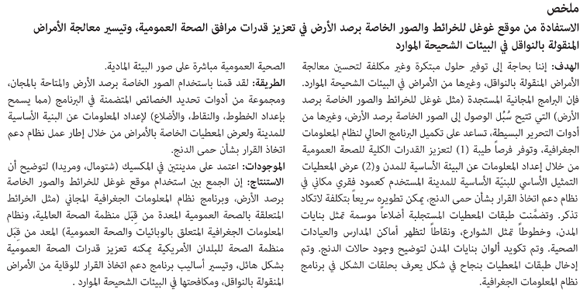
Introduction
Vector-borne diseases inflict a terrible and unacceptable public health burden in developing countries. Indeed, seven of the 10 diseases targeted by the WHO Special Programme for Research and Training in Tropical Diseases because of their overwhelming public health and socioeconomic importance are transmitted by arthropods (African trypanosomiasis, Chagas disease, dengue, filariasis, leishmaniasis, malaria and onchocerchiasis). New, inexpensive solutions for management of these and other vector-borne diseases in resource-poor environments are desperately needed.
Use of a geographic information system (GIS), which is a system for input, storage, manipulation, and output of geographic information, provides a powerful tool to combat vector-borne diseases. There is a plethora of GIS software packages available, with capacities for data processing, analysis and display ranging from low to high. Table 1 outlines characteristics, relative to Google Earth (Google, Mountain View, CA, United States of America), of four commonly used GIS software with data processing, analysis and display capacities ranging from low (HealthMapper, WHO, Geneva, Switzerland; Epi Info/Epi Map, Centers for Disease Control and Prevention, Atlanta, Georgia, USA) to moderate (SIGEpi, Pan American Health Organization, Washington, DC, USA), and high (ArcGIS, ESRI, Redlands, CA, USA).
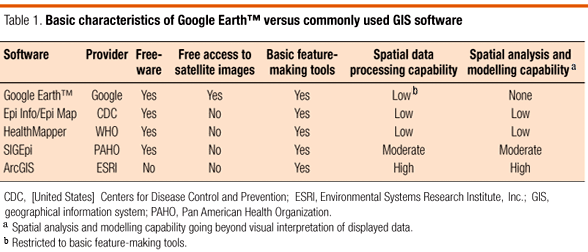
GIS-based approaches have, for example, been used to visualize or model spatial patterns of risk for exposure to malaria parasites in Africa13 and dengue virus in different parts of the world.47 This provides crucial information facilitating allocation of resources to the areas most in need of vector and disease control. GIS spatial backbones also have been incorporated into information systems or decision support systems for management of vector-borne diseases. Examples include systems for malaria surveillance and control in India, Mexico and southern Africa,813 management of insecticide resistance in African malaria vectors,14 and dengue surveillance and control in Brazil, Singapore and Thailand.1518 A dengue decision support system (DDSS) with a GIS spatial backbone is currently being developed at Colorado State University funded by the Innovative Vector Control Consortium.19 In a sister project, the Medical Research Council of South Africa is developing a Malaria Decision Support System.19
Use of GIS technology to support management of vector-borne diseases does, however, require access to basic geographic data layers. In the case of dengue, which is predominantly an urban disease,20 a GIS data layer showing the basic infrastructure of a city (streets, city blocks, location of health facilities, etc.) is crucial. Unfortunately, resource-poor environments in need of GIS-based solutions to more effectively manage vector-borne diseases can be faced with the reality that even the most basic GIS data are lacking and that investment in the infrastructure (high end computers, sophisticated GIS software, technical personnel) needed to develop such data is cost-prohibitive. We therefore explored the potential for using novel software providing free access to satellite imagery and including simple editing tools (e.g. Google EarthTM and Microsoft® Virtual Earth, Microsoft Corp., Redmond, WA, USA) to generate basic data layers for city infrastructure. Previous uses of Google EarthTM in public health include: display of public health information following Hurricane Katrina in New Orleans, USA;21 visualization of public health records in Sweden;22 interactive mapping of strategic health authorities in England;23 display of information related to a global malaria atlas project; tracking of dengue cases in Singapore; and tracking of the global spread of avian influenza.24
The goal of this study was to demonstrate that Google EarthTM can be used to strengthen overall public health capacity through development of information for city infrastructure and to display public health data in map formats.
Methods
We used satellite imagery and feature-making tools provided through Google EarthTM to develop city infrastructure data layers including labelled polygons representing city blocks, lines representing streets, and points showing the locations of schools, health clinics, etc.; and to generate block-level city maps showing the distribution of blocks with dengue cases. Data layers were successfully imported as shapefiles (a format which stores the geometry for a feature as a set of vector coordinates) into GIS software. In addition, we explored the potential for incorporating Google EarthTM into a DDSS for two cities in southern Mexico: Chetumal in Quintana Roo State (population: approximately 135 000) and Merida in Yucatan State (population: approximately 800 000). GIS-based data from INEGI (Instituto Nacional de Estadística, Geografía e Informática; Aguascalientes, Mexico) with a spatial resolution fine enough to display basic geostatistical areas (BGSAs), streets, and city blocks had already been developed for these two cities. GIS data for BGSAs available to us included various socioeconomic factors. The City of Merida also recently produced a GIS-based city representation including data for individual premises.25 Nevertheless, these cities serve as practical examples of the potential for satellite imagery and editing tools to generate information for city infrastructure useful as a spatial backbone in a local DDSS. Satellite images for Chetumal and Merida were accessed during an online internet session with Google EarthTM (examples of image quality in Fig. 1, Fig. 2, Fig. 3 and Fig. 4; Fig. 1 and Fig. 2 are available at: http://www.who.int/bulletin/volumes/86/9/07-045880/en/index.html). We then investigated the generation and incorporation of data into features that could be used in the decision support system and imported into GIS packages.
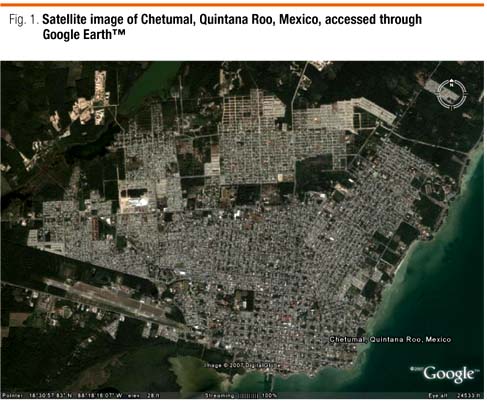



Findings
Visualization of spatial patterns of dengue
Images captured during an online session can be stored on a desktop computer to allow for subsequent off-line work without internet access using the stand-alone Google EarthTM desktop application. Although there were small patches of cloud cover in the images, their overall quality was adequate to determine the outlines of city blocks, streets, and even individual buildings. Using the polygon, line (path) and point (placemark) tools supplied with Google EarthTM, we generated polygons representing city blocks, lines representing streets, and points representing home addresses for persons afflicted with dengue (georeferenced with a GPS receiver) or locations of schools, hospitals, health clinics, and cemeteries (Fig. 3, Fig. 4, Fig. 5, Fig. 6 and Fig. 7). The development of a representation of the city of Chetumal (Fig. 5) complete with labelled blocks, streets, schools and health facilities required approximately 80 person-hours and was accomplished by one person with no previous experience of Google EarthTM.
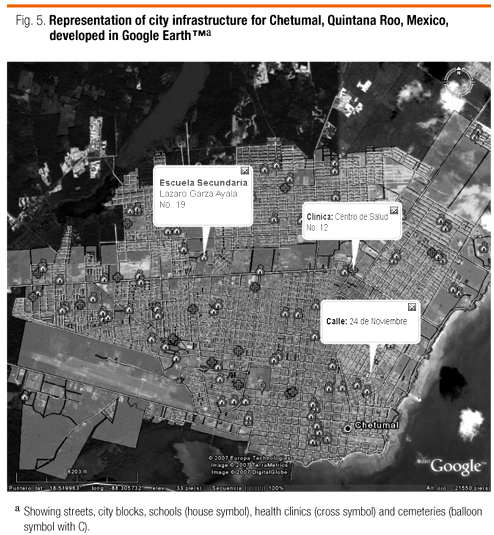
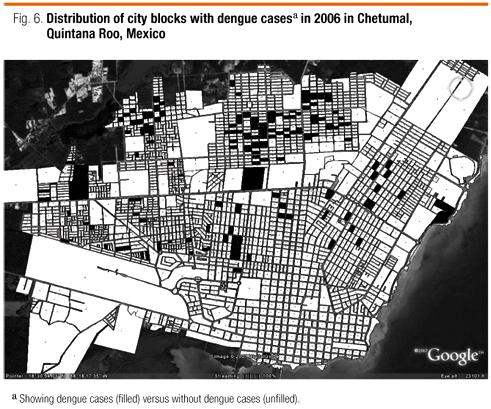
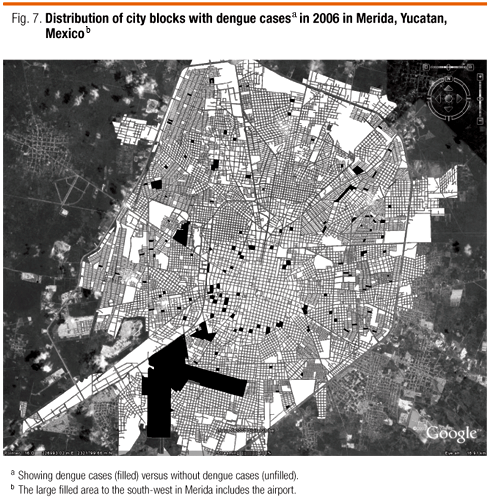
The feature-making tools in the application are simple and intuitive to use. Points are added to the image by clicking on the placemark tool and then can be located by " dragging" them to their desired locations in the image or by entering specific coordinates such as those derived from a GPS receiver. A line is added by simply clicking on the path tool and then clicking on the desired start and end points for the line in the image. A polygon is similarly generated by clicking on the polygon tool and then clicking on the corners of the area in the image the polygon will represent; this tool allows for production of polygons with an infinite variety of shapes. Polygons, lines and points can be individually labelled (with both name and an extended description of the feature) and displayed in various colours selected from an extensive palette. This colour option allows for simultaneous display of different diseases (i.e. vector-borne, foodborne, waterborne) of interest to the local public health community. In addition, points can be represented by different icons (examples in Fig. 5).
As an example of the potential for using Google EarthTM to visualize spatial patterns of vector-borne diseases, we developed city maps showing the location of blocks with dengue cases reported in 2006 for Chetumal and Merida (Fig. 6 and Fig. 7). This type of map provides information on where people are most at risk of exposure to dengue virus and can be used to guide limited mosquito vector and dengue prevention, surveillance, and to control resources to the areas of a city at highest risk. Multi-year data for spatial distribution of dengue cases within a city also can be used to create a spatial priority area classification scheme for emergency vector control activities during dengue outbreaks when vector control resources are overwhelmed and decisions must be made regarding the order in which to treat different parts of a city. It also should be noted that disease case locations can be displayed directly on a Google EarthTM image of the physical environment (not shown), which provides additional intuitive information of the environment in which the cases occur (for example in relation to the presence of water sources potentially serving as breeding grounds for anopheline malaria vectors).
Incorporation into a dengue decision support system
Google EarthTM was also incorporated as one option for display of information in a map format in a DDSS framework (Fig. 8). As part of DDSS software under development at Colorado State University, Visual Basic 2005® (Microsoft Corp.) was used to design a management tool for extraction of information from a DDSS data warehouse (PostgreSQL database with a PostGIS extension) and subsequent generation of chart, graph, map and text outputs. Google EarthTM map outputs are generated through a series of program subroutines to extract the required information from the data warehouse and produce a Keyhole Markup Language (KML) file, a format used for expressing geographic annotation and visualization for display in Google EarthTM. The DDSS software will, when completed, be made freely available to the public health end-user community. Based on the preference and resources of the end-user, DDSS map outputs can be displayed either in Google EarthTM or in GIS software (Fig. 8).

In addition to serving as an option for display of map outputs, Google EarthTM may prove useful to build a spatial backbone for a local DDSS in situations where GIS data are incomplete or lacking (Fig. 8). Physical features that can be mapped directly from a satellite image include roads, streets, city blocks, rivers and lakes. In addition, features not directly visible on the image can be added; these include schools, hospitals, health clinics and administrative units bounded by streets (e.g. neighbourhoods of a city).
Transfer of information to GIS software
The data developed for Chetumal and Merida using Google EarthTM were successfully transferred into a commonly used GIS software (ArcGIS9.2, ESRI). Google EarthTM uses the KML file format for geographic visualization.26 KML uses a tag-based structure with nested elements and attributes and is based on the XML standard (Fig. 9, available at: http://www.who.int/bulletin/volumes/86/9/07-045880/en/index.html). A MultiGeometry function allows a KML file to include information on multiple features (polygons, paths, placemarks). For example, the information in the map shown in Fig. 5 is contained within a single KML file. Transfer of a KML file from Google EarthTM to GIS software is achieved by extracting the KML geographic elements and creating a shapefile. Conversion from KML to shapefile, or from shapefile to KML, can be done through various already available tools; in this instance Arc2Earth software was used for the transformation from KML to shapefile.27

Human subjects
Data for locations of dengue cases were provided by Servicios de Salud de Yucatan and Servicios Estatales de Salud de Quintana Roo under protocols approved by the Institutional Review Board at Colorado State University. Map-based presentation of these data (Fig. 6 and Fig. 7) is restricted to city blocks.
Discussion
Need for new tools and solutions
Vector-borne and other infectious diseases place tremendous public health burdens on developing countries. Even when management solutions are available, many are not economically feasible to implement in the areas with the most desperate need. One part of the new frontier in infectious disease research must therefore be to adapt technologically advanced and costly concepts for disease management to operational use in resource-poor environments through development of low-cost tools and solutions. Google EarthTM is an excellent example of a freely accessible tool with great potential for improving public health. The software provides access to satellite images of high quality in urban areas and includes a set of simple editing tools that can be used both for display of various public health information and to generate information on city and public health infrastructure. Benefits and limitations of using Google EarthTM are outlined in the following sections and its basic properties versus commonly used GIS software are summarized in Table 1.
Benefits
Google EarthTM has several attractive features. First, this free software is very simple and intuitive to use. We expect most public health professionals to easily develop proficiency in its use through an unsupervised brief session of working with the software. Second, the varied colour options for placemarks (points) and polygons allow for development of maps simultaneously showing information related to multiple diseases or public health initiatives. Third, it is a stand-alone desktop software application. This is important because internet access can be inconsistent or very slow even in urban areas in developing countries. Internet access is needed only briefly to capture a satellite image which can be stored on the user's computer and processed off-line. Fourth, the quality of imagery is already sufficient in many urban areas to allow the viewer to distinguish individual houses. Together with information collected on the ground, this can support development of computer-based premise-level maps crucial for management of information related to participation in public health campaigns (e.g. the Patio Limpio programme currently being implemented in Mexico and aiming to enrol home-owners in source-reduction efforts to remove breeding grounds for the dengue virus vector Aedes aegypti). Fifth, the quality of the satellite imagery is constantly improving. Sixth, Google EarthTM-generated KML files can readily be shared; they also can be imported as shapefiles into a GIS software for spatial analysis of the included data. Finally, there is a large user community with online support groups for technical issues.
We used Google EarthTM-derived city infrastructure representations to generate maps showing the spatial distribution of city blocks with dengue cases in Chetumal and Merida, Mexico, in 2006 (Fig. 6 and Fig. 7). Similar maps can be developed for any number of vector-borne, zoonotic, waterborne, or foodborne diseases where case locations are available. This spatial information can, using dengue as an example, be used to facilitate focused operational vector surveillance and control activities targeting high-risk areas. By dividing the number of annual disease cases within a city block with the number of houses within the block, one also can generate a simple block-specific index for disease incidence per house and year. Merging blocks will allow for calculation of the same index for any desired combination of blocks or the entire city.
With adequate funding and access to high-quality satellite imagery, Google EarthTM can be used to generate basic data for infrastructure (roads, villages, streets, city blocks, schools, health clinics, etc.) and major environmental features (rivers, lakes, etc.) for all parts of the world where such information currently is lacking or unreliable in a GIS format. A global assessment is needed to determine in which geographical areas high-quality images coincide with poorly developed GIS databases; these are the areas where this application has the greatest potential to improve public health capacity.
Limitations
Google EarthTM has several limitations. Perhaps the most profound drawback is the need to access the internet to capture satellite images of areas of interest. Although internet access is increasing, especially in urban areas, this requirement will impede its use in some parts of the world. Image quality also presents a potential stumbling block. Often, we have found image quality to be excellent in urban environments in developing countries but very poor in rural areas, which limits its usefulness for diseases occurring commonly in rural settings (e.g. malaria). The age of images also varies, which presents a problem in rapidly growing urban environments. Other drawbacks include a limited set of editing and data management tools and a lack of spatial analysis and modelling capability (Table 1). Finally, Google EarthTM uses the world geodetic system (WGS) 84, which is best suited for country-wide or continent-wide scales.
We expect some of these limitations to be addressed in the future. The critical issue of image quality can be improved by Google purchasing additional satellite imagery. The editing tool and data management capacity will undoubtedly improve in the future as new versions of the software are released and additional editing or data management tools are generated and made available by the user community. For example, we have developed tools for: (i) conversion between geographic coordinates in WGS 84 and Universal Transverse Mercator (UTM) projection which is better suited for limited areas such as the cities of Cheumal and Merida; and (ii) creation of centroids for generated polygons.
Flexibility in DDSS application
Dengue occurs in a wide range of environments in Africa, the Americas and Asia. The DDSS framework under development therefore must be flexible enough to address the needs of a diverse end-user community. Potential for use of GIS software as well as Google EarthTM as options for display of DDSS-generated data in map formats provides flexibility for the user community to select the display method best suiting their needs and resources. In a resource-poor environment, we expect a DDSS end-user with limited computer skills to be able to generate map outputs in Google Earth showing the spatial distribution of dengue cases or mosquito vector information. These maps can be used internally by vector or dengue control programmes to guide prevention, surveillance, and control efforts to high-risk areas and also can be distributed externally to inform the public and local decision-makers of spatial risk patterns.
In a resource-poor environment, use of Google EarthTM likely will be combined with use of free GIS software such as the HealthMapper or SIGEpi. As noted previously, KML files generated in Google EarthTM can be imported as shapefiles into GIS software for spatial analysis. This is important because GIS software can provide access to various socioeconomic and environmental data and spatial statistical analysis capacity lacking in Google EarthTM. In more affluent environments with availability of specialized personnel, we expect high-end and expensive GIS software, such as ArcGIS, rather than Google EarthTM and free GIS software to be used in the DDSS framework.
Conclusions
The combination of Google EarthTM and free GIS software (e.g. the HealthMapper, SIGEpi) has tremendous potential to strengthen overall public health capacity and facilitate decision support system approaches to prevention and control of vector-borne diseases in resource-poor environments. Basic information for city infrastructure can, if lacking in a GIS format, be rapidly generated using freely available satellite imagery and feature-making tools. Key beneficial features of the stand-alone desktop Google EarthTM software include access to satellite imagery of often very high quality in urban areas, a set of user-friendly feature-making tools to produce individually labelled and colourized polygons, lines, and points, and potential for conversion of KML files into shapefiles to import into GIS software. Key limitations include the need to access the internet for initial capture of a satellite image, poor image quality in many rural areas, and lack of spatial analysis and modelling capability. We have successfully incorporated Google EarthTM as one option alongside GIS software for display of information in a map format in a DDSS framework. 
Acknowledgements
We thank Jesus Valentin Miss-Dominguez from Universidad Autónoma de Yucatán and William MayMedina of Servicios Estatales de Salud de Quintana Roo for georeferencing of dengue case locations and Jacobo Misael Canul-Chin, Juan Carlos Sosa-Muy, and Francisco Javier Gamboa-Garcia from Universidad Autónoma de Yucatán and Aaron Tadeo-Manzanares from Servicios Estatales de Salud de Quintana Roo for assistance with DDSS development.
Funding: The study was funded by the Innovative Vector Control Consortium as part of the Dengue Decision Support System project.
Competing interests: None declared.
References
1. Mapping Malaria Risk in Africa [homepage on the internet]. MARA/ARMA: 2004. Available from: http://www.mara.org.za/ [accessed on 4 June 2008] .
2. Kleinschmidt I, Omumbo J, Briet O, van de Giesen N, Sogoba N, Mensah NK, et al. An empirical malaria distribution map for West Africa. Trop Med Int Health 2001;6:779-86. PMID:11679126 doi:10.1046/j.1365-3156.2001.00790.x
3. Hay SI, Snow RW. The Malaria Atlas Project: developing global maps of malaria risk. PLoS Med 2006;3:e473. PMID:1762059 doi:10.1371/journal.pmed.0030473
4. Communicable Disease Global Atlas DengueNet initiative. Geneva: WHO; 2008. Available from: http://www.who.int/globalatlas/default.asp [accessed on 4 June 2008] .
5. Carbajo AE, Schweigmann N, Curto SI, de Garin A, Bejaran R. Dengue transmission risk maps of Argentina. Trop Med Int Health 2001;6:170-83. PMID:11299033 doi:10.1046/j.1365-3156.2001.00693.x
6. Indaratna K, Hutubessy R, Chupraphawan S, Sukapurana C, Tao J, Chunsutthiwat S, et al. Application of geographical information systems to co-analysis of disease and economic resources: dengue and malaria in Thailand. Southeast Asian J Trop Med Public Health 1998;29:669-84. PMID:10772545
7. Rotela C, Fouque F, Lamfri M, Sabatier P, Introini V, Zaidenberg M, et al. Spacetime analysis of the dengue spreading dynamics in the 2004 Tartagal outbreak, Northern Argentina. Acta Trop 2007;103:1-13. PMID:17603989 doi:10.1016/j.actatropica.2007.05.003
8. Booman M, Durrheim DN, La Grange K, Martin C, Mabuza AM, Zitha A, et al. Using a geographical information system to plan a malaria control programme in South Africa. Bull World Health Organ 2000;78:1438-44. PMID:11196490
9. Booman M, Sharp BL, Martin CL, Manjate B, La Grange JJ, Durrheim DN. Enhancing malaria control using a computerised management system in southern Africa. Malar J 2003;2:13. PMID:12816547 doi:10.1186/1475-2875-2-13
10. Martin C, Curtis B, Fraser C, Sharp B. The use of a GIS-based malaria information system for malaria research and control in South Africa. Health Place 2002;8:227-36. PMID:12399212 doi:10.1016/S1353-8292(02)00008-4
11. Sharp BL, Kleinschmidt I, Streat E, Maharaj R, Barnes KI, Durrheim DN, et al. Seven years of regional malaria control collaboration - Mozambique, South Africa, and Swaziland. Am J Trop Med Hyg 2007;76:42-7. PMID:17255227
12. Srivastava A, Nagpal BN, Saxena R, Eapen A, Ravindran KJ, Subbarao SK, et al. GIS based malaria information management system for urban malaria scheme in India. Comput Methods Programs Biomed 2003;71:63-75. PMID:12725965 doi:10.1016/S0169-2607(02)00056-1
13. Hernandez-Avila JE, Rodriguez MH, Betanzos-Reyes AF, Danis-Lozano R, Mendez-Galvan JF, Velazquez-Monroy OJ, et al. Determinant factors for malaria transmission on the coast of Oaxaca State, the main residual transmission focus in Mexico. Salud Publica Mex 2006;48:405-17. PMID:17063824
14. Coleman M, Sharp B, Seocharan I, Hemingway J. Developing an evidence-based decision support system for rational insecticide choice in the control of African malaria vectors. J Med Entomol 2006;43:663-8. PMID:16892622 doi:10.1603/0022-2585(2006)43[663:DAEDSS]2.0.CO;2
15. Rosa-Freitas MG, Tsouris P, Sibajev A, de Souza Weimann ET, Marques AU, Ferreira RL, et al. Exploratory temporal and spatial distribution analysis of dengue notifications in Boa Vista, Roraima, Brazilian Amazon, 1999-2001. Dengue Bull 2003;27:63-80.
16. Teng TB. New initiatives in dengue control in Singapore. Dengue Bull 2001;25:1-6.
17. Ai-leen GT, Song RJ. The use of GIS in ovitrap monitoring for dengue control in Singapore. Dengue Bull 2000;24:110-6.
18. Sithiprasasna R, Patpoparn S, Attatippaholkun W, Suvannadabba S, Srisuphanunt M. The geographic information system as an epidemiological tool in the surveillance of dengue virus-infected Aedes mosquitos. Southeast Asian J Trop Med Public Health 2004;35:918-26. PMID:15916091
19. Hemingway J, Beaty BJ, Rowland M, Scott TW, Sharp BL. The Innovative Vector Control Consortium: improved control of mosquito-borne diseases. Trends Parasitol 2006;22:308-12.
20. Gubler DJ. The changing epidemiology of yellow fever and dengue, 1900 to 2003: Full circle? Comp Immunol Microbiol Infect Dis 2004;27:319-30. PMID:15225982 doi:10.1016/j.cimid.2004.03.013
21. Curtis AJ, Mills JW, Leitner M. Spatial confidentiality and GIS: Re-engineering mortality locations from published maps about Hurricane Katrina. Int J Health Geogr 2006;5:44. PMID:17032448 doi:10.1186/1476-072X-5-44
22. Sundvall E, Nyström M, Forss M, Chen R, Petersson H, Åhlfeldt H. Graphical overview and navigation of electronic health records in a prototyping environment using Google Earth and openEHR archetypes. Medinfo 2007; 129:1043-7.
23. Boulos MNK. Web GIS in practice III: Creating a simple interactive map of England's Strategic Health Authorities using Google Maps API, Google Earth KML, and MSN Virtual Earth Map Control. Int J Health Geogr 2005;4:22. PMID:16176577 doi:10.1186/1476-072X-4-22
24. Google Earth Outreach. Public Health. Available from: http://www.google.com/earth/outreach/p_health.html [accessed on 4 June 2008] .
25. Merida Yucatán SIG. City of Merida. Available from: http://www.merida.gob.mx/sig/ [accessed on 4 June 2008] .
26. Google Earth KML. What is KML? Available from: http://code.google.com/apis/kml/ [accessed on 4 June 2008] .
27. Arc2Earth. Available from: http://www.arc2earth.com/default.htm [accessed on 4 June 2008] .
(Submitted: 9 July 2007 Revised version received: 2 January 2008 Accepted: 4 January 2008 Published online: 6 June 2008)
1 Correspondence to Lars Eisen (e-mail: lars.eisen@colostate.edu).
doi:10.2471/BLT.07.045880
